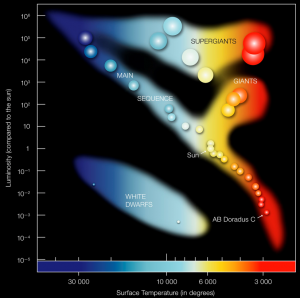By Emma Goldberg
Although the night sky appears peaceful and calm, the stars we see at night are constantly expanding, exploding, and redesigning our galaxy – making the universe a very exciting place to be! And right now, all eyes are on Betelgeuse: a bright reddish star 642 light-years away that acts as the shoulder of Orion in his constellation (Figure 2). And the excitement over Betelgeuse is well-deserved, because it’s getting ready to “go supernova”! What, exactly, does this mean? Well, let’s review some astronomy!
A star is born when clouds of dust and gas, called nebulae, become so heavy that they collapse in on themselves. Most of the gas in these clouds is hydrogen and helium. The center of this “space cloud” collapse is called a protostar, and as it collects dust and gas it grows bigger and bigger until it becomes a star!
Stars come in all shapes and colors, and we can classify them accordingly. The Hertzsprung-Russell Diagram (HR diagram, Figure 3) is the most well-known star classification system. It was developed in the early 1900s and classifies stars by either their temperature and energy (luminosity), or by their color and absolute brightness, respectively. A star’s initial mass will determine which classes it will belong to throughout its life.
One thing is always true, however: a star can only burn for so long! In general, the larger the star, the shorter its lifetime. When a star has run out of its first energy source (hydrogen), its core begins to collapse and its temperature increases. This rise in temperature forces the outer part of the star to explode, transforming the star into a red giant – or, if it’s large enough, a supergiant! Supergiants burn helium gas – the same gas that makes your balloons float! And they’ll continue burning this helium until it runs out. Then, they’ll burn heavier and heavier gases and elements until the core is full of iron, which is the equivalent to the powder that remains after you make a fire! When there is no fuel left for the supergiant, its core explodes and we call this a supernova explosion (Figure 4). A supernova explosion can shine as brightly as an entire galaxy!
Back to Betelguese: Betelgeuse is a red supergiant with a mass that is 10-20 times that of our Sun! Betelgeuse is thought to be between 8-8.5 million years old, and it has been a supergiant for 40,000 years, meaning that it has already used up its core hydrogen energy and is now burning helium gas. Starting in late 2019, scientists noticed that the brightness of Betelgeuse was beginning to change — it was dimming. In fact, astronomers (scientists who study stars, moons and planets) measured a decrease in brightness of about 25% since September 2019! Coupled with a decrease in surface temperature, this suggests that the red supergiant has INCREASED in size, possibly getting ready to enter the next stage of its life: the supernova. If Betelgeuse turns into a supernova, it would shine as brightly as the moon in our sky – and we’d be able to observe it for weeks!
So, keep your eyes to the skies and look out for the Betelgeuse Supernova!!!
Edited by Elise Hickman and Rachel Battaglia




